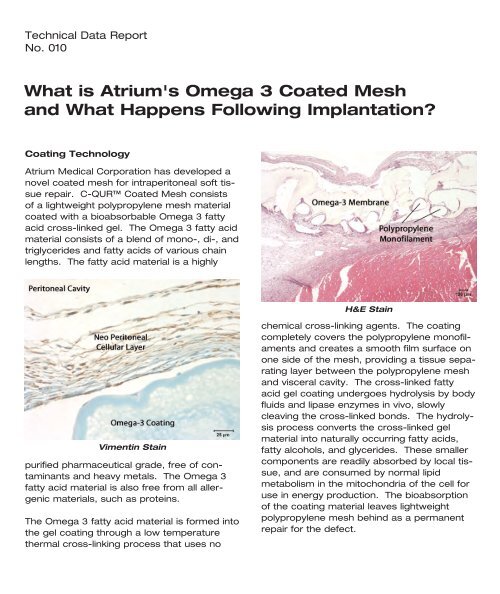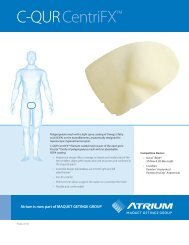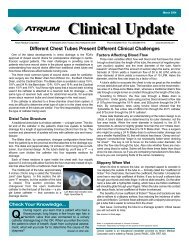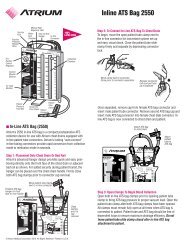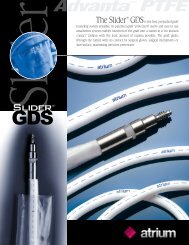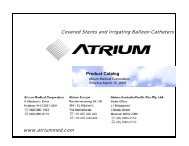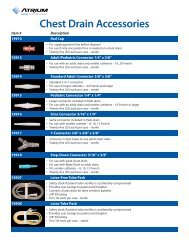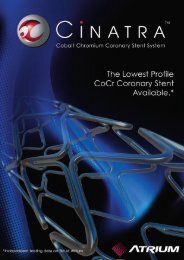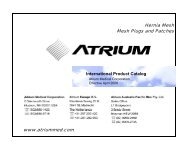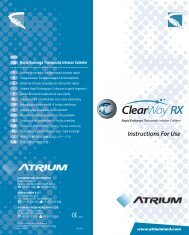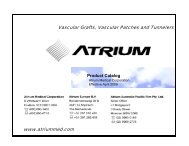No. 010 What is Atrium's Omega 3 Coated Mesh and What Happens ...
No. 010 What is Atrium's Omega 3 Coated Mesh and What Happens ...
No. 010 What is Atrium's Omega 3 Coated Mesh and What Happens ...
You also want an ePaper? Increase the reach of your titles
YUMPU automatically turns print PDFs into web optimized ePapers that Google loves.
Technical Data Report<br />
<strong>No</strong>. <strong>010</strong><br />
<strong>What</strong> <strong>is</strong> <strong>Atrium's</strong> <strong>Omega</strong> 3 <strong>Coated</strong> <strong>Mesh</strong><br />
<strong>and</strong> <strong>What</strong> <strong>Happens</strong> Following Implantation?<br />
Coating Technology<br />
Atrium Medical Corporation has developed a<br />
novel coated mesh for intraperitoneal soft t<strong>is</strong>sue<br />
repair. C-QUR <strong>Coated</strong> <strong>Mesh</strong> cons<strong>is</strong>ts<br />
of a lightweight polypropylene mesh material<br />
coated with a bioabsorbable <strong>Omega</strong> 3 fatty<br />
acid cross-linked gel. The <strong>Omega</strong> 3 fatty acid<br />
material cons<strong>is</strong>ts of a blend of mono-, di-, <strong>and</strong><br />
triglycerides <strong>and</strong> fatty acids of various chain<br />
lengths. The fatty acid material <strong>is</strong> a highly<br />
Vimentin Stain<br />
purified pharmaceutical grade, free of contaminants<br />
<strong>and</strong> heavy metals. The <strong>Omega</strong> 3<br />
fatty acid material <strong>is</strong> also free from all allergenic<br />
materials, such as proteins.<br />
The <strong>Omega</strong> 3 fatty acid material <strong>is</strong> formed into<br />
the gel coating through a low temperature<br />
thermal cross-linking process that uses no<br />
H&E Stain<br />
chemical cross-linking agents. The coating<br />
completely covers the polypropylene monofilaments<br />
<strong>and</strong> creates a smooth film surface on<br />
one side of the mesh, providing a t<strong>is</strong>sue separating<br />
layer between the polypropylene mesh<br />
<strong>and</strong> v<strong>is</strong>ceral cavity. The cross-linked fatty<br />
acid gel coating undergoes hydrolys<strong>is</strong> by body<br />
fluids <strong>and</strong> lipase enzymes in vivo, slowly<br />
cleaving the cross-linked bonds. The hydrolys<strong>is</strong><br />
process converts the cross-linked gel<br />
material into naturally occurring fatty acids,<br />
fatty alcohols, <strong>and</strong> glycerides. These smaller<br />
components are readily absorbed by local t<strong>is</strong>sue,<br />
<strong>and</strong> are consumed by normal lipid<br />
metabol<strong>is</strong>m in the mitochondria of the cell for<br />
use in energy production. The bioabsorption<br />
of the coating material leaves lightweight<br />
polypropylene mesh behind as a permanent<br />
repair for the defect.


